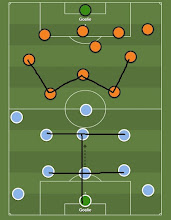A number of goalless games in EURO deserve better credit as they mark the
top form of both goalkeepers.
Goalless games are probably considered the dullest part of football. In
every tournament or competition, there is bound to be one or more. Naturally,
such matches never attract fans, as most would see how both sides missed shots
on goals or spurned chances. However, the stalemate could also demonstrate how
goalkeepers from both sides were in top form and almost equally denied the
shots to keep the clean sheets. In short, some goalless games are not about the
duels of forwards but the contests of the defenders on both ends of the
backline, but the goalkeepers’ show.
In EURO 2024, three games have resulted in a stalemate. Two of which are in
the final games of Group C, when both clashes saw no goals at all. Yet, both
England vs. Slovenia and Denmark vs. Serbia are not regarded as the best
goalless games since both goalies’ saves were not dominant. Such matches are
rare. Here are those kinds of games in EURO history where both shot stoppers
stole the spotlight.
Sweden vs Turkey (Group Stage, EURO 2000)
It was the second match in Group B of EURO 2000. Both Sweden and Turkey were
beaten in the opener by the hosts, Belgium and Italy, respectively. The Swedes
and the Turks aimed for a win in order to keep their chance to progress alive.
The game itself was tight as both sides created chances with several shots
on target. Yet, both goalies stole the show by making clinical saves. Sweden’s
Magnus Hedman did so three times, while Turkey’s Rustu Recber saved four attempts, including a dangerous free kick from Kennet Anderson earlier in the
game. Meanwhile, Hedman saved one of Turkey’s shots on target by Arif Erdem.
Eventually, it was Hakan Sukur and Co. who went through the knockout stage
after a stunning 2-0 victory over the host, which was also Turkey’s first win
in EURO history. Blagut, at the same time, was unable to pick up the three
points needed while taking on Italy. Consequently, Henrik Larsson and Co. had
to go home early.
Denmark vs Italy (Group Stage, EURO 2004)
It was
the opener in Group D, which was a tight affair between the two sides. The
Danish Dynamite had Aston Villa’s Thomas Sorensen, while Gli Azzurri still had
the prime Gianluigi Buffon between the sticks. Italy was surely the favourite
to clinch the first three points.
In
reality, Giovanni Trappatoni’s men were left frustrated. Despite having the
best forwards at his disposal, with the likes of Cristian Vieri, Alessandro Del
Piero, Antonio Cassano, and Francesco Totti upfront, they were unable to find
the back of the net. Sorensen made five clinical saves. Totti was even sent
off. Fortunately, such an advantage could not be optimised by the Danes. Morten
Olsen’s men faced the same problem as Buffon made eight heroic saves.
Eventually, a stalemate was inevitable.
However,
both had a contrary campaign in the competition. Denmark went on to win 2-0
over Bulgaria before sharing spoils with their Nordic neighbour, Sweden, in the
following two fixtures, whereas Italy only mustered a 1-1 draw versus Blagut
and snatched a 2-1 win against Bulgaria. Despite collecting the same points,
Denmark deserved a place in the next stage to accompany Sweden, as they had a
better goal difference.
Sweden vs Netherlands (Quarterfinals, EURO 2004)
If the
Danes experienced it early in EURO 2004, the Swedes had to go through it later.
In the quarterfinal, Sweden had to take on the Netherlands. Lars Lagerback and
Tommy Soderberg’s men had Zlatan Ibrahimovic and Henrik Larsson lead the line.
De Oranje still had Arjen Robben, Ruud Van Nilsterooy, and Andy Van der Meyde
upfront.
The game
was not exactly dull, as both teams traded attacks and shots on goals for
almost the entire 120 minutes. Both Andres Isaksson and Edwin Van der Saar
played crucial roles in the clean sheet. The former Manchester City shot
stopper managed to make more than seven to nine saves, while the Dutch
legendary goalie denied five shots. The game had to end on penalties.
In the
shootout, the ex-Ajax, Juventus, Fulham, and Manchester United man, Van der
Sar, demonstrated his quality and experience at the top level. He was the protagonist, as he was the only one who denied the penalty. Such was enough to lead
them to progress to the semifinals.
Spain vs Italy (Quarterfinals, EURO 2008)
The clash between Spain and Italy in EURO 2008 was a decisive game that
changed the future of the Spanish national team. Prior to their success in
2008, they were more notorious for their frequent failures at the quarterfinals
or round of 16 in major tournaments. In 2008, it was no different, as many had
doubts about whether they could eliminate Italy, who was the World Cup winner
at the time.
The game was exciting, with Spain dominating the game, relying on tiki taka,
while Gli Azzurri deployed a counterattack to score. Xavi Hernandez and Co.
were on the verge of another elimination as they were left frustrated to break
the deadlock. A number of chances by David Villa, David Silva, or Fernando
Torres were spurned. Their top goalie, Gianluigi Buffon, also saved more than
five shots on target. Meanwhile, his counterpart made three clinical saves. The
stalemate was inevitable.
The match then went to penalties. Both goalkeepers did manage to deny the
shots, too. Yet, it was Casillas’s turn this time to exceed Buffon. The Real
Madrid shot stopper saved twice, whereas the former Parma man did only once. La
Furia Roja sent their fans into raptures and went on to win their second title.



Comments
Post a Comment